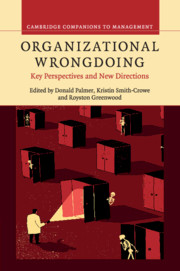Book contents
- Frontmatter
- Contents
- List of figures
- List of tables
- List of contributors
- Foreword
- 1 The imbalances and limitations of theory and research on organizational wrongdoing
- 2 On taking the theoretical substance of outcomes seriously: a meta-conversation
- 3 Wrong paths to right: defining morality with or without a clear red line
- 4 From market enablers to market participants: redefining organizational and political-legal arrangements and opportunities for financial wrongdoing,1930s–2000
- 5 Wrongdoing and market development: an examination of the distinct roles of trust and distrust
- 6 Bad apples, bad barrels and bad cellars: a “boundaries” perspective on professional misconduct
- 7 S/he blinded me with science: the sociology of scientific misconduct
- 8 Social networks and organizational wrongdoing in context
- 9 Falling stars: celebrity, infamy, and the fall from (and return to) grace
- 10 Compensation and employee misconduct: the inseparability of productive and counterproductive behavior in firms
- 11 Beware of organizational saints: how a moral self-concept may foster immoral behavior
- 12 “Is it me? Or is it me?” The role of coactivated multiple identities and identifications in promoting or discouraging workplace crimes
- 13 Consequences of organizational misconduct: too much and too little punishment
- 14 Who bears the brunt? A review and research agenda for the consequences of organizational wrongdoing for individuals
- 15 Organizational wrongdoing and media bias
- 16 Ethical learning: releasing the moral unicorn
- Index
Foreword
Published online by Cambridge University Press: 05 July 2016
- Frontmatter
- Contents
- List of figures
- List of tables
- List of contributors
- Foreword
- 1 The imbalances and limitations of theory and research on organizational wrongdoing
- 2 On taking the theoretical substance of outcomes seriously: a meta-conversation
- 3 Wrong paths to right: defining morality with or without a clear red line
- 4 From market enablers to market participants: redefining organizational and political-legal arrangements and opportunities for financial wrongdoing,1930s–2000
- 5 Wrongdoing and market development: an examination of the distinct roles of trust and distrust
- 6 Bad apples, bad barrels and bad cellars: a “boundaries” perspective on professional misconduct
- 7 S/he blinded me with science: the sociology of scientific misconduct
- 8 Social networks and organizational wrongdoing in context
- 9 Falling stars: celebrity, infamy, and the fall from (and return to) grace
- 10 Compensation and employee misconduct: the inseparability of productive and counterproductive behavior in firms
- 11 Beware of organizational saints: how a moral self-concept may foster immoral behavior
- 12 “Is it me? Or is it me?” The role of coactivated multiple identities and identifications in promoting or discouraging workplace crimes
- 13 Consequences of organizational misconduct: too much and too little punishment
- 14 Who bears the brunt? A review and research agenda for the consequences of organizational wrongdoing for individuals
- 15 Organizational wrongdoing and media bias
- 16 Ethical learning: releasing the moral unicorn
- Index
Summary
In the 1987 film Wall Street, written and directed by Oliver Stone, the main character Gordon Gekko says “Greed, for lack of a better word is good. Greed is right; greed works. Greed clarifies, cuts through, and captures the essence of the evolutionary spirit.” This rationalization of wrongdoing – exemplified by Enron, Arthur Andersen, WorldCom, and so on, and some very recent examples as well (e.g., Libor rigging of inter-bank interest rates by banks, VW car emissions scandal) – makes this book a timely reminder of misconduct in the workplace and its consequences for individuals, businesses, and society. The volume editors, Donald Palmer, Kristin Smith-Crowe, and Royston Greenwood, have put together the latest research by some of the most prominent academics and scholars in the field, to highlight “a wide range of unethical, socially irresponsible, and illegal behaviors” engaged in by senior executives and others in a variety of organizations for personal gain, or to enhance their promotion, or to cover up their incompetence or lack of goal achievement, and so on.
The book explores some of the following issues: the limitations and imbalances of theory and research on organizational wrongdoing, workplace morality, market enablers to wrongdoing (an historical review), trust and mistrust, a boundaries perspective of professional misconduct, social networks and organizational wrongdoing, compensation and employee misconduct, the consequences of misconduct, the media portrayal of wrongdoing, and other very important topics.
Although business wrongdoing has been around since trade began, through the Industrial Revolution to the conglomerates of today, the “big data age” and media scrutiny have more quickly highlighted corporate corruption. Now that the light is able to shine on these events, we are more able to explore organizational wrongdoing and business ethics than in the past. This volume provides the science and informed debate on where we go from here in creating more ethical workplaces. As Plato said, “there are not many very good or very bad people, but the great majority are something between the two.” We need to create more ethical organizational cultures for the majority.
- Type
- Chapter
- Information
- Organizational WrongdoingKey Perspectives and New Directions, pp. xxv - xxviPublisher: Cambridge University PressPrint publication year: 2016

